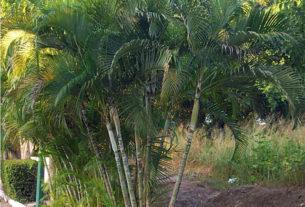My guide book tells me that it’s exactly 1,000 kilometers from Guadalajara to Oaxaca. That’s about 660 miles. I know of people who say they’ve driven the distance in one day and I have to concede that it’s possible. The only way you can do it is to take toll roads the whole way, start at the crack of dawn and drive like hell. The other thing you have to do is drive through Mexico City. My wife and I love driving toll roads and we don’t mind a long day’s drive. However, we both have a complete mental block about driving in or through Mexico City. We’ve never done it. We will probably never do it. So anything we have to say about driving to Oaxaca from the Guadalajara area is predicated on the complete avoidance of Mexico City. We’ve never met anyone who says that isn’t a good idea.
Probably the best advice we ever received about driving through Mexico City was to drive to the outskirts and then hire a taxi driver to guide us to the other side. But even the man who suggested it agreed after some thought that it wasn’t one of the world’s great ideas. Consequently we’ve never done it.
We’ve made the drive twice from Guadalajara to Oaxaca. The first time, we made Taxco our first day’s destination. The second time we drove to Cuernavaca and stopped over there. With an early morning start you can make both cities easily by afternoon.
The distance from Guadalajara to Cuernavaca is 635 kilometers. Taxco is a slightly shorter trip.
When you leave Guadalajara you take the toll road, Highway 15, to Toluca, a distance of some 482 kilometers. It’s a generally straightforward drive. Whatever the cost, we feel it’s worthwhile. We actually have driven the slow road from Guadalajara to Toluca, through Morelia. Morelia looks like a nice city and you get to see some wonderful pine forests and mountain vistas in the surrounding area. Unfortunately you also get to pass through countless towns and villages. And you get to drive over countless topes (speed bumps to the aficionado) and to negotiate countless hairpin bends. It takes at least three hours longer than the toll road. So, yes, the tolls are worth whatever they cost.
The toll roads are exactly like interstates. Turn on the cruise control and turn up the music and simply drive. There are about eight toll stations between Guadalajara and Toluca. They all have clean washrooms and places where you can get gas, auto service, as well as a good selection of snacks and drinks. The roads themselves are well-maintained and they’re safe. And there isn’t a whole lot of traffic. In fact, there’s no better way to go where you’re going in Mexico. Some advertise that they take credit cards but we’ve found that isn’t true at all toll stations. Also, they usually mean Mexican credit cards. We’ve had Canadian VISA cards refused.
Toluca can be a bit of a problem. It’s a big, busy industrial city and there’s no nice convenient throughway running either through or around it. You have to keep following the signs for Ixtapan de la Sal on Highway 55 in order to get out of town. The good news is there are lots of signs. So hang in, be patient and you’ll make it, although the drive seems rather endless.
Ixtapan is a popular spa, famous for its mud baths, just south of Toluca. It’s a busy place on the weekends. You have to go through it to get to either Taxco or Cuernavaca. If Ixtapan de la Sal looks interesting it’s yet another option as a place to stop over. There’s lots of accommodation and there are plenty of places to dine. We stayed twice at Hotel Bungalows Lolita just off Highway 55 and found it quite to our liking. The rooms are adequate, the prices are reasonable and the pool is large. Nobody seems to go there mid-week but the huge dining room is an indication that the weekends are very busy.
Taxco is about 40 kilometers from Ixtapan de la Sal. Cuernavaca is approximately 80 kilometers away. The highway to both places is good, although it’s not a toll road. The route is quite mountainous but doesn’t present any problems to drivers. Indeed, there are some fabulous mountain views to stop and admire. Whether you go to Taxco or Cuernavaca probably depends on what your guidebook says about each one. Both are well worth visiting.
Taxco is Mexico’s famous silver city, built on the side of a mountain. There are wall-to-wall silver shops and lots of other attractions. The city is a spectacular sight as you approach on Highway 55.
Cuernavaca is a popular weekend refuge for folks fleeing Mexico City on the weekends. They’re known as capitalistas. Cuernavaca, too, has lots of attractions and a fabulous climate. El Centro’s two side-by-side zócalos are interesting places to wander.
Frankly, neither town is a lot of fun to drive in if you don’t know where you’re going. Taxco has lots of hills — in fact, it’s all hill. To the driver it’s a warren of narrow, winding streets infested with Volkswagon Beetles. We solved our problem of finding a place to stay by picking up a guide at the city entrance and letting him take us to a place in the main square — Hotel Agua Escondida. It wasn’t the kind of place where you come home raving about old world charm but it was perfectly okay. And we liked being right on the zócalo, which is a constantly lively place, day or night. Our guide also showed us how to get around town and, as you might expect, took us to a silver shop. In any event, we considered his services well worth the twenty dollars we paid him.
On our trip to Cuernavaca we were quite proud of our navigation skills. Using the road map, and a very skimpy city map we actually drove straight to the hotel we chose from our Frommer’s Mexico 1996 just in time to get the last room in the place. Hotel Cadiz was listed in the ‘inexpensive’ section, with a description that began: “Every now and then I discover a hotel with the kind of homey charm that makes me want to return. Such is the Hotel Cadiz…” Well, it wasn’t quite that good but we got a decent night’s accommodation. The good thing, too, is that the Cadiz is only a short stroll from all the downtown activities..
The hotel couldn’t accommodate us for a second night because several Swiss lady cyclists were expected the next day. However, the owner graciously found us alterative accommodation at the Posada San Angelo. This is a 17 room mansion converted into an inn, complete with pool, restaurant, secure parking and lots of Mexican charm. It’s at Cerrada de la Selva #100 which is only a 10 peso taxi ride from the zócalo. It was twice the price of the Cadiz but we considered it a good deal. It’s the place we’ll go back to when we return to Cuernavaca.
The 456 kilometers from Cuernavaca to Oaxaca takes the better part of a day to drive. It’s not one of the world’s great drives. There are lots of ups and downs and curves and corners – none of them dangerous but they’re enough to keep you from getting up speed. You can just about forget your cruise control. The only relief you get is when you finally reach the Puebla to Oaxaca toll road, Highway 190. However, you’re only 70 kilometers from Oaxaca at that point.
There are a few towns of some substance: Cuautla, Izucar de Matamoros, Acatlan, Huajuapan de León, but none of them look too appealing. It’s an arid desert/mountain landscape stretching for miles in all directions. When you stop for a break or a change of drivers the stillness and complete silence only add to the desolation. In the event that you need to stop overnight, there’s a modern hotel, the Casa Blanca, on the highway, just south of Huajuapan de León. My Sanborn’s Mexico Travelog says it’s a nice place with 65 rooms, restaurant and pool. And they take credit cards.
The one thing that sets my imagination going on that drive are the many churches one sees along the way — some still active, some merely ruins. The striking feature is that those churches are — or were — structures of such grandeur and beauty. They stand conspicuously tall against the dusty terrain. The landscape is primitive and the villages humble. Yet here, incongruously, are these shining steeples and these beautiful examples of man’s creation. There are simply no other man-made structures anywhere in the vicinity that approach them in beauty and in the scope and ambition of their builders. Just as driving across the United States makes me wonder about the people who actually endured the journey in covered wagons, I’m left wondering about the harsh lives of those monks and nuns, four hundred years ago, who came to this absolutely desolate place and felt impelled to erect these marvellous churches.
Probably the most spectacular of all is at Yanhuitlan where you’ll encounter the ruin of a massive Dominican convent built around 1550. It’s right on the highway. You can’t possibly miss seeing it. It’s a very impressive structure and worth a visit. The church has had some restoration work done on it but the convent, which must have housed an enormous number of people in its day, is a ruin. Again, you’re left wondering about the people who lived here centuries ago with their dreams of erecting these magnificent edifices to a faith that we, today, can scarcely imagine. I don’t think there’s any modern equivalent for the conviction that drove those people to their tasks.
The site is open from 10 a.m. to 6 p.m. and there’s a small admission charge. Yanhuitlan, by the way, is pretty close to the end of your journey.
Shortly after Yanhuitlan you’ll merge with Highway 190, the toll road, which will take you right into Oaxaca in less than an hour.
Good luck — and plan on staying a few days in Oaxaca. It’s everybody’s favorite town in Mexico. It’s such a pity it takes so long to get there.



